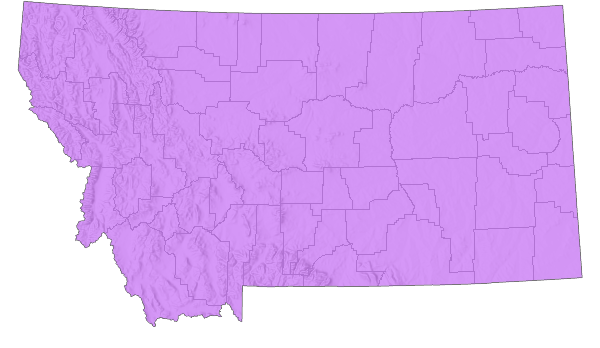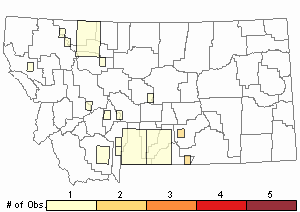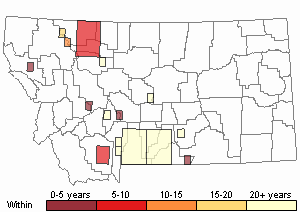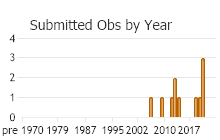View in other NatureServe Network Field Guides
NatureServe
Montana
Utah
Wyoming
Idaho
Wisconsin
British Columbia
South Carolina
Yukon
California
New York
Mormon Cricket - Anabrus simplex
Other Names:
Mormon Shield-backed Katydid
General Description
The following is taken from Helfer (1971), Capinera and Sechrist (1982), Vickery and Kevan (1985), Pfadt (2002), Capinera et al. (2004), Bailey et al. (2007), and Scott (2010). The Mormon Cricket is not a true cricket, but a flightless shieldbacked katydid in the family Tettigoniidae, often referred to as “Dectids” (subfamily Tettigoniinae, tribe Decticinae), subfamily Decticinae [the shieldbacks]). This is a large-sized robust species with short wings concealed by the pronotum. In some male’s, the wings extend posteriorly, slightly beyond the hind margin of the pronotum. The hind femur is short, being no longer than twice the length of the pronotum. The body color is variable, from brown to shining black or grass green, sometimes uniform, but more commonly mottled. The female possesses an upward curved ovipositor. Antennae are longer than the body. The Mormon Cricket occurs in both solitary and gregarious forms resulting in body color variations. Solitary populations on the eastern slope of the Rocky Mountains are typically colored brown or green, whereas the more widely distributed gregarious populations are typically black.
Calling song description
The male song has been verbally described as a “shrill, whistling sound” or a “squeaking noise.” Calling males are basically unaffected by temperature regimes since they tolerate cold conditions more than other species of katydids and crickets. A male usually stops calling once he makes contact with a female (Gwynne 1984 and 2001, Bailey et al. 2007, Walker SINA website 2020).
Phenology
The eggs are laid in summer and attain full development by fall when they diapause before entering winter dormancy. At high elevations embryonic development may be delayed which prolongs egg incubation an extra year. Nymphs begin hatching in spring when the soil temperatures reach 40 degrees F, survive cool spring weather and emerge at much lower temperatures than many other Orthoptera species within their habitats. Adults occur from June to September (Capinera and Sechrist 1982, Vickery and Kevan 1985, Pfadt 2002, Capinera et al. 2004, Scott 2010).
Diagnostic Characteristics
The following comes from Hebard (1928), Helfer (1971), Capinera and Sechrist (1982), Vickery and Kevan (1985), McDaniel (1987), Pfadt (2002), Capinera et al. (2004), and Scott (2010). The pronotal (thorax) length of the male is 7-<15 mm and for females, 9-15 mm. The male body length is 39-43 mm, and females are 41-49 mm, her ovipositor >19->22 mm. The male cerci are parallel and strongly curved inward with the lower branches acute and much longer than the upper branch which is blunt or slightly pointed (see illustration).
The Mormon Cricket is easily confused with any of the shieldbacked katydids (subfamily
Tettigoniinae), especially its congener, the
Long-legged Anabrus (
A. longipes), but this species has been reported for only one northwest Montana county.
Species Range
Montana Range
Range Descriptions

 Native
Native
Range Comments
This species is widespread over the Great Plains from the Dakotas, Nebraska, and Kansas, westward to the eastern limit of the mountain ranges of Washington, Oregon and northern California. North from southeastern British Columbia, southern Alberta, Saskatchewan and Manitoba, southward to northern Arizona and New Mexico. In Montana, it has been reported for 33 counties (Gurney 1939, Capinera and Sechrist 1982, Vickery and Kevan 1985, Capinera et al. 2004, Pfadt 2002, and Scott 2010).
Observations in Montana Natural Heritage Program Database
Number of Observations: 57
(Click on the following maps and charts to see full sized version)
Map Help and Descriptions
Relative Density

Recency



 (Observations spanning multiple months or years are excluded from time charts)
(Observations spanning multiple months or years are excluded from time charts)
Migration
The following is taken from Cowan (1929), Gwynne (2001), and Pfadt (2002). After the eggs hatch and the first two nymphal instar stages are complete, the Mormon Crickets form small gatherings, accumulating into larger groups called bands, whereupon they begin their daily movements. Measured population densities of Mormon Crickets can range from 1 individual per square yard to over 100 per square yard, with densities growing gradually over several years reaching outbreak proportions. Once their populations have reached outbreak densities, they begin an extensive migration to the foothills, grasslands, and croplands. These marches occur only during the warm daylight hours throughout their life into the adult stage, and generally march at a rate of one-eighth to 1.25 miles per day. They only halt during rain, extreme heat (when soil surface temperatures reach =110° F), and the cooler hours of night when the band seeks “roosting shelter” beneath vegetation. In the morning, they begin emerging from their roosts when the temperature reaches about 40° F and bask in patches of sunlight, warming-up for the next daily march. The course of the march is oriented in a single, straight direction and never deviates from any obstacles, houses, barns, etc. There are observations of these marches merging into other bands, forming massive fronts more than 1 mile wide and 10 miles deep, which often result in oily, slippery roads when crushed by traffic and devastates considerable acreages of agricultural crops in their endless search for food (refer to Management below). They cease migrating 2-3 hours before sunset, bask on the ground facing west, individually or in clusters of 25-50 individuals, sitting close together. They also cluster on fence posts, utility poles and the sides of buildings. During the last three hours of daylight, Mormon Crickets also do much of their feeding before retreating to their shelters or roosts.
Habitat
The Mormon Cricket inhabits a wide variety of open, scantily vegetated areas where sagebrush and forbs dominate. Large populations occur in the sagebrush-grass associations in the Great Basin and the mountain ranges of the Rocky Mountains where they occur in small resident populations in forest openings from 6500 feet to the alpine tundra at 11,000 feet (Vickery and Kevan 1985, Pfadt 2002).
Food Habits
The following comes from Cowan (1929), Vickery and Kevan (1985), Gwynne (2001), and Pfadt (2002). The Mormon Cricket has been observed feeding on more than 400 plant species, but it discriminates on its choice of foods, preferring succulent forbs in the wild such as milkvetches, penstemons,
arrow-leaf balsamroot (
Balsamorhiza sagittata), dandelion, wild mustard, tumble-mustard, and pepperweed. It also consumes shrubs associated with its habitat such as saltbush and three species of sagebrush. At certain times during its seasonal occurrence, it may restrict its diet to 2 to 4 species available in its habitat. The Mormon Cricket especially favors seeds, but grasses are low on their preferred food list, therefore, this species is not as significant an impact upon livestock forage as was once thought. They voraciously feed upon such cultivated plants as wheat, barley, alfalfa, sweetclover, truck crops and garden vegetables. The Mormon Cricket also consumes fresh manure, other wounded or dead insects, dead snakes, and any kind of dead flesh, raw or cooked. They also practice cannibalism, dining on the sick and wounded of their kind and gather at “roadkill” sites to feed upon squashed members of their migrating band.
Reproductive Characteristics
The following is taken from Cowan (1929), Gwynne (1984), Vickery and Kevan (1985), Gwynne (2001), and Pfadt (2002). Courting and mating takes place 10 to 14 days after reaching the adult stage. The male sings from a perch in the vegetation. When an attracted female approaches, the male either drops to the ground or the female climbs the perch. When the female mounts the male, he curls into a C-shaped position beneath her, whereupon they couple. The male transfers a large white spermatophore to the female’s genitalia, consisting of two parts, a small ampulla (flask) containing two pockets of sperm and a large protein-rich bulb called the spermatophylax, after which the pair separates. While the sperm is draining into the female’s spermatheca, she eats the spermatophylax, eventually consuming the empty ampulla acquiring extra nutrients and proteins for egg production. Eggs are deposited in bare ground, often on mounds of
Western Harvester ants (
Pogonomyrmex occidentalis). After laying one egg, she removes her ovipositor, covers the exit hole, and moves to another location to repeat the process. Lab tests indicate that a single female lays an average of 86 eggs, but some have been observed to lay as many as 160. Egg-laying generally occurs in intervals of about 7 days and can take place at any time of day, but the greater number of eggs are usually laid in the afternoon. Mormon Crickets produce one generation per year. In colder high mountain habitats, two years may be required to produce a single generation. The nymphs pass through 7 instars before reaching the adult stage. For more detail regarding the complexity of this species’ courtship and mating systems and reversed sex roles, refer to the above references, especially those published by Darrel Gwynne.
Management
The following comes from Cowan (1929), Claude and Parker (1947), Vickery and Kevan (1985), Gwynne (2001), and Pfadt (2002). Measured population densities of Mormon Crickets can range from 1 individual per square yard to over 100 per square yard, with densities growing gradually over several years, which eventually reach outbreak proportions. Feeding tests indicate that one cricket per square yard, from its nymphal period and 20 days of adult life, consumes an amount of vegetation equal to 38 pounds (dry weight) per acre. Due to their migratory habit, Mormon Crickets may remain at a site for no more than 3 or 4 days. Damages to agricultural and garden crops can be sizeable and can lay waste to large areas of cultivated fields. During the 1937 outbreak, crop damage in Montana amounted to $500,000 and in Wyoming amounted to $383,000. See references for more historical and more recent outbreak information.
Stewardship Responsibility
References
- Literature Cited AboveLegend:
 View Online Publication
View Online Publication Bailey, N.W., D.T. Gwynne, W.V. Bailey, and M.G. Ritchie. 2007. Multiple differences in songs and other traits between solitary and gregarious Mormon Crickets from allopatric mtDNA clades. BMC Evolutionary Biology 7(5):1-11.
Bailey, N.W., D.T. Gwynne, W.V. Bailey, and M.G. Ritchie. 2007. Multiple differences in songs and other traits between solitary and gregarious Mormon Crickets from allopatric mtDNA clades. BMC Evolutionary Biology 7(5):1-11. Capinera, J.L. and T.S. Sechrist. 1982. Grasshoppers of Colorado: Identification, Biology, and Management. Fort Collins, CO: Colorado State University Experiment Station, Bulletin 584S. 161 p.
Capinera, J.L. and T.S. Sechrist. 1982. Grasshoppers of Colorado: Identification, Biology, and Management. Fort Collins, CO: Colorado State University Experiment Station, Bulletin 584S. 161 p. Capinera, J.L., R.D. Scott, and T.J. Walker. 2004. Field Guide to Grasshoppers, Katydids, and Crickets of the United States. Ithaca, NY. Cornell University Press.
Capinera, J.L., R.D. Scott, and T.J. Walker. 2004. Field Guide to Grasshoppers, Katydids, and Crickets of the United States. Ithaca, NY. Cornell University Press. Cowan, F.T. 1929. Life history, habits, and control of of the Mormon Cricket. Washington, D.C.: U.S.D.A. Technical Bulletin No. 161. 28 p.
Cowan, F.T. 1929. Life history, habits, and control of of the Mormon Cricket. Washington, D.C.: U.S.D.A. Technical Bulletin No. 161. 28 p. Gurney, A.B. 1939. Aids to the identification of the Mormon and Coulee Crickets and their allies (Orthoptera; Tettigoniidae, Gryllacrididae). U.S.D.A. Bureau of Entomology and Plant Quarantine Bulletin E. 30 p.
Gurney, A.B. 1939. Aids to the identification of the Mormon and Coulee Crickets and their allies (Orthoptera; Tettigoniidae, Gryllacrididae). U.S.D.A. Bureau of Entomology and Plant Quarantine Bulletin E. 30 p. Gwynne, D.T. 1984. Sexual selection and sexual differences in Mormon Crickets (Orthoptera: Tettigoniidae, Anabrus simplex). Evolution 38(5):1011-1022.
Gwynne, D.T. 1984. Sexual selection and sexual differences in Mormon Crickets (Orthoptera: Tettigoniidae, Anabrus simplex). Evolution 38(5):1011-1022. Gwynne, D.T. 2001. Katydids and Bush-Crickets, Reproductive Behavior and Evolution of the Tettigoniidae. Ithaca, NY: Cornell University Press.
Gwynne, D.T. 2001. Katydids and Bush-Crickets, Reproductive Behavior and Evolution of the Tettigoniidae. Ithaca, NY: Cornell University Press. Hebard, M. 1928. The Orthoptera of Montana. Proceedings of the Academy of Natural Sciences of Philadelphia, Vol. 80:211-306.
Hebard, M. 1928. The Orthoptera of Montana. Proceedings of the Academy of Natural Sciences of Philadelphia, Vol. 80:211-306. Helfer, J.R. 1971. How to Know the Grasshoppers, Crickets, Cockroaches, and Their Allies. Revised edition (out of print), Mineola, NY: Dover Publications.
Helfer, J.R. 1971. How to Know the Grasshoppers, Crickets, Cockroaches, and Their Allies. Revised edition (out of print), Mineola, NY: Dover Publications. McDaniel, B. 1987. Grasshoppers of South Dakota. Brookings, SD: South Dakota Agricultural Experiment Station, Bulletin TB 89.
McDaniel, B. 1987. Grasshoppers of South Dakota. Brookings, SD: South Dakota Agricultural Experiment Station, Bulletin TB 89. Pfadt, R.E. 2002. Field Guide to Common Western Grasshoppers, 3rd edition. Laramie, WY: Wyoming Agricultural Experiment Station, Bulletin 912, modified by S. Schell and S. Schell for electronic publication. Accessed 19 February 2020. http://www.uwyo.edu/entomology/grasshoppers/field-guide/index.html#fieldguidetoc
Pfadt, R.E. 2002. Field Guide to Common Western Grasshoppers, 3rd edition. Laramie, WY: Wyoming Agricultural Experiment Station, Bulletin 912, modified by S. Schell and S. Schell for electronic publication. Accessed 19 February 2020. http://www.uwyo.edu/entomology/grasshoppers/field-guide/index.html#fieldguidetoc Scott, R.D. 2010. Montana Grasshoppers, Katydids, and Crickets A Pictorial Field Guide to the Orthoptera. MagpieMTGraphics, Billings, MT.
Scott, R.D. 2010. Montana Grasshoppers, Katydids, and Crickets A Pictorial Field Guide to the Orthoptera. MagpieMTGraphics, Billings, MT. Vickery, V. R. and D. K. M. Kevan. 1985. The grasshopper, crickets, and related insects of Canada and adjacent regions. Biosystematics Research Institute, Ottawa, Ontario. Publication Number 1777. 918 pp.
Vickery, V. R. and D. K. M. Kevan. 1985. The grasshopper, crickets, and related insects of Canada and adjacent regions. Biosystematics Research Institute, Ottawa, Ontario. Publication Number 1777. 918 pp. Wakeland, C. and J.R. Parker. 1947. The Mormon Cricket. U.S.D.A., Yearbook of Agriculture: Insects. 4 p.
Wakeland, C. and J.R. Parker. 1947. The Mormon Cricket. U.S.D.A., Yearbook of Agriculture: Insects. 4 p. Walker T.J.(ed.). 2020. Singing insects of North America. Accessed 10 February 2021. https://orthsoc.org/sina/
Walker T.J.(ed.). 2020. Singing insects of North America. Accessed 10 February 2021. https://orthsoc.org/sina/
- Additional ReferencesLegend:
 View Online Publication
View Online Publication
Do you know of a citation we're missing? Caudell, A.N. 1907. The Decticinae (a Group of Orthoptera) of North America. Proceedings of the National Museum 32:285-410.
Caudell, A.N. 1907. The Decticinae (a Group of Orthoptera) of North America. Proceedings of the National Museum 32:285-410. Fulton, B.B. 1933. Stridulating organs of female Tettigoniidae (Orthoptera). Entomological News XLIV:270-275.
Fulton, B.B. 1933. Stridulating organs of female Tettigoniidae (Orthoptera). Entomological News XLIV:270-275. Hewitt, G.B., E. Huddleston, R.J. Lavigne, D.N. Ueckert, and J.G. Watts. 1974. Rangeland Entomology. Denver, CO: Society for Range Management, Range science Series No. 4. 127 p.
Hewitt, G.B., E. Huddleston, R.J. Lavigne, D.N. Ueckert, and J.G. Watts. 1974. Rangeland Entomology. Denver, CO: Society for Range Management, Range science Series No. 4. 127 p. Hitchcock, O.B. 1939. Some factors affecting the development of the eggs of the Mormon cricket (Anabrus simplex Hald). M.Sc. Thesis. Bozeman, MT: Montana State University. 27 p.
Hitchcock, O.B. 1939. Some factors affecting the development of the eggs of the Mormon cricket (Anabrus simplex Hald). M.Sc. Thesis. Bozeman, MT: Montana State University. 27 p.
- Web Search Engines for Articles on "Mormon Cricket"
- Additional Sources of Information Related to "Insects"





